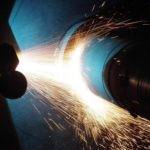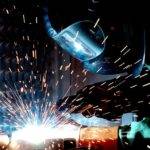What Is Thermal Spray?
Thermal Spray is the method that involves heating materials in order to spray onto solidified materials, creating a coating or seal. Using this method creates a thick and effective coating in less time than other coating methods. There are many advantages that come with using thermal spraying.
Benefits Of Thermal Spray
 As heated particles flatten and bond tightly to the substrate, thermal spraying is versatile. In other words, regardless of the coating material, by choosing thermal spray you have a comprehensive choice of coating materials that will meet your application needs, including strong protection from damage such as corrosion and wear. Thermal spraying is not restricted to certain substrates. It has the capacity to form functional coatings and barriers on a number of different surfaces. However, it is not necessary for the coating made by thermal spraying to fuse with the substrate to create a bond.
As heated particles flatten and bond tightly to the substrate, thermal spraying is versatile. In other words, regardless of the coating material, by choosing thermal spray you have a comprehensive choice of coating materials that will meet your application needs, including strong protection from damage such as corrosion and wear. Thermal spraying is not restricted to certain substrates. It has the capacity to form functional coatings and barriers on a number of different surfaces. However, it is not necessary for the coating made by thermal spraying to fuse with the substrate to create a bond.
Another great aspect of thermal spraying is using minimal heating to create a solid coat on the substrate. Coatings can also be applied to substrates that are heat sensitive such as plastics and low melting point metals. In addition, coatings such as metal, ceramic, and cermet, is applicable to any substrate that withstands the heat of gas jets and impinging particles. As thick coatings of thermal spray can often be applied at high deposition rates, it shows that thermal spraying is also great for component reclamation. At a low cost, usually at a fraction of the replacement price, parts can be rebuilt quite quickly. With thermal spraying being recognized as a key process for combining specialized materials and coatings, it has the ability to create freestanding structures for ceramics of high performance and graded materials. Thermal spraying has been used for rapid solidification and is advancing into the synthesis of advanced surfaces such as solid oxide fuel cells, dielectrics, ferrites, and bioactive materials.
At Wilcox, our thermal spraying implementation will provide your product with three key advantages. Your product will see an increase in productivity and performance and a reduction of failure downtime. As such, thermal spraying will improve your product’s properties where and when you need them the most. By investing in this process, your product will last longer and save you the time and effort to look for replacements or a replica. Wilcox High Velocity uses thermal spray on a variety of materials including the following:
- Aluminum
- Babbit
- Brass
- Carbides
- Ceramics
- Soft Alloys
- Stellite
- Stainless Steels
Depending on your materials, different processes might be involved in the completion of your project, each with its unique method. Applications may sometimes overlap in the sense that in addition to thermal spraying, hard facing may also be an acceptable solution to providing your project with resistant surfaces. As we take great care in completing your project in a timely manner, we will evaluate which method will be the most beneficial and efficient to get the job done.
Thermal Spray Processes
With our ability to use a variety of materials and techniques to fit the specifications and needs of your project, there are a variety of thermal spray techniques we utilize. Some of our technique examples include the following:
- Wire Arc Spraying
- Flame Spraying
- High-Velocity Oxy-Fuel Coating Spraying (HVOF)
Wire arc spray is a form of the thermal spray that involves two consumable metal wires being fed independently into a spray gun. This process is often a favorite by customers and ourselves. Wire arc spray allows us to apply advanced coating materials inexpensively and quickly at high efficient rates. As such, this method often translates into savings to our happy customers. Flame spraying is far more advanced and has similar advantages to the other processes, particularly easy application at a lost cost. The flame spray process is easy to operate and simple in design with lower equipment costs compared to plasma and HVOF. With high deposition rates, the deposited coating costs are much lower than most thermal spraying processes. Lastly, advantages to HVOF primarily lie within improving coat quality. This thermal process has tougher coatings which increase your product’s wear resistance and improved corrosion protection.
Questions?
Thermal spray can be a difficult concept to understand when you’re not in the industry. We’ve outlined briefly the advantages to you investing in his helpful welding process. If you are interested in further information about thermal spraying, here is a comprehensive overview on what thermal spray consists of and its processes. For any questions or concerns regarding our processes, how we work, how long your project will take, and anything else, do not hesitate to contact Wilcox today!
